The thought of leaving the beach causes me pangs of regret, as I am not ready to leave yet. I have really enjoyed my early morning walks along the cliffside path, and my sunset swims in the gentle surf. I have made friends across the rooftop breakfast table at Debra’s guesthouse, had dinner with the couple I met in Alleppey, and met a “swimming friend” Piret, a lovely woman from Switzerland whom I met while swimming in the surf. We have taken to meeting up for conversation at the popular “Coffee Temple” along the cliffside path.
Piret has been in Varkala for four months now, but must go back to Switzerland to see her children. She plans to come back next winter for six months, and suggests perhaps we could share a flat next winter to save the expense of our respective hotels. I can’t imagine where I will be next month, I tell her. Let alone next year.
But at the same time, I know I will return to Varkala one day. There is just something special about this place, with all the comforts of a beach resort, yet still it manages to maintain an intimate ambiance.
The only thing that makes leaving the beach tolerable is knowing I will be returning once I work my way north to Goa, another beachside destination along India’s western coastline in another week. But for now, I have a date for a ride on a Unesco World Heritage train!

First Class leads the way on the Nilgiri Mountain Railway, while the steam engine is in the back, pushing us up the mountain.

The steepest section of the route will be powered by steam locomotive. The engine is traded out for an oil powered locomotive halfway up at Coonoor.

The route from Mettupalayam to Ooty is only 30 miles, but it will take 4.5 hours. Niligiri Mountain train is known as the slowest train in India. But the air is cool, the scenery beautiful, and I am in no hurry. 😉
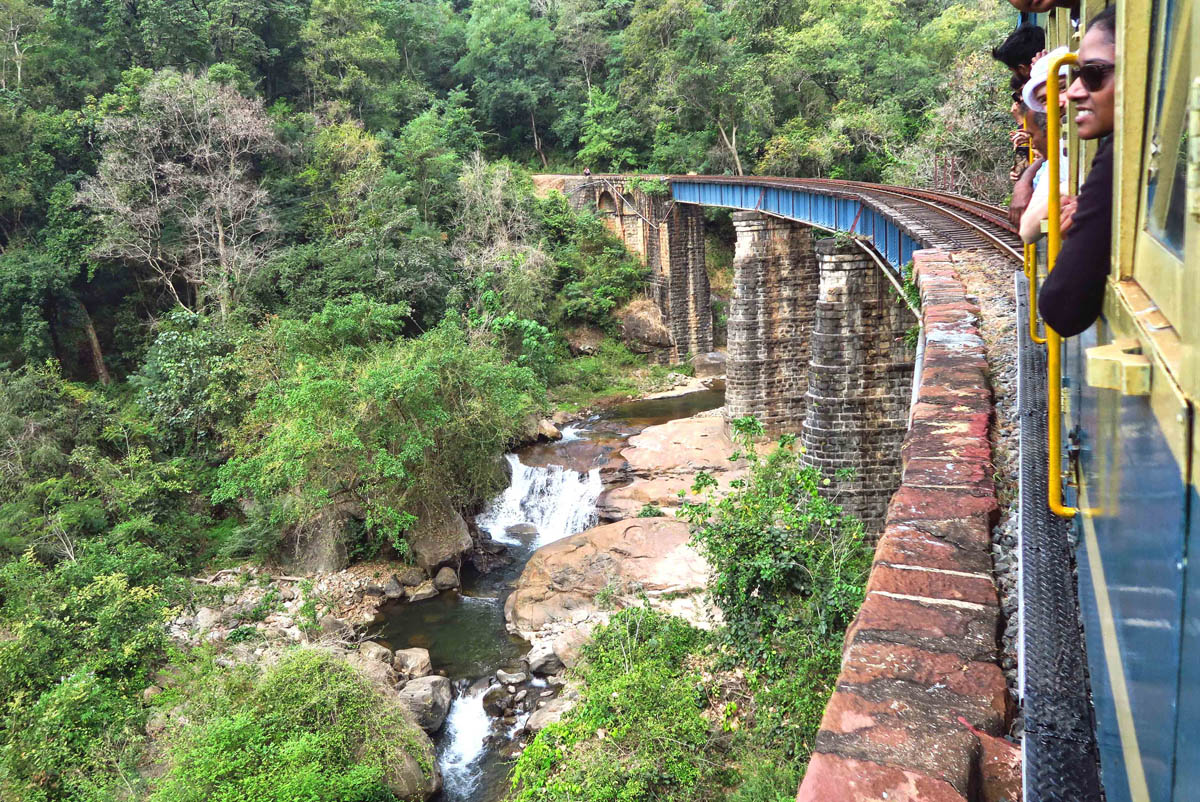
Best seat is the window seat on the left side heading up the mountain.
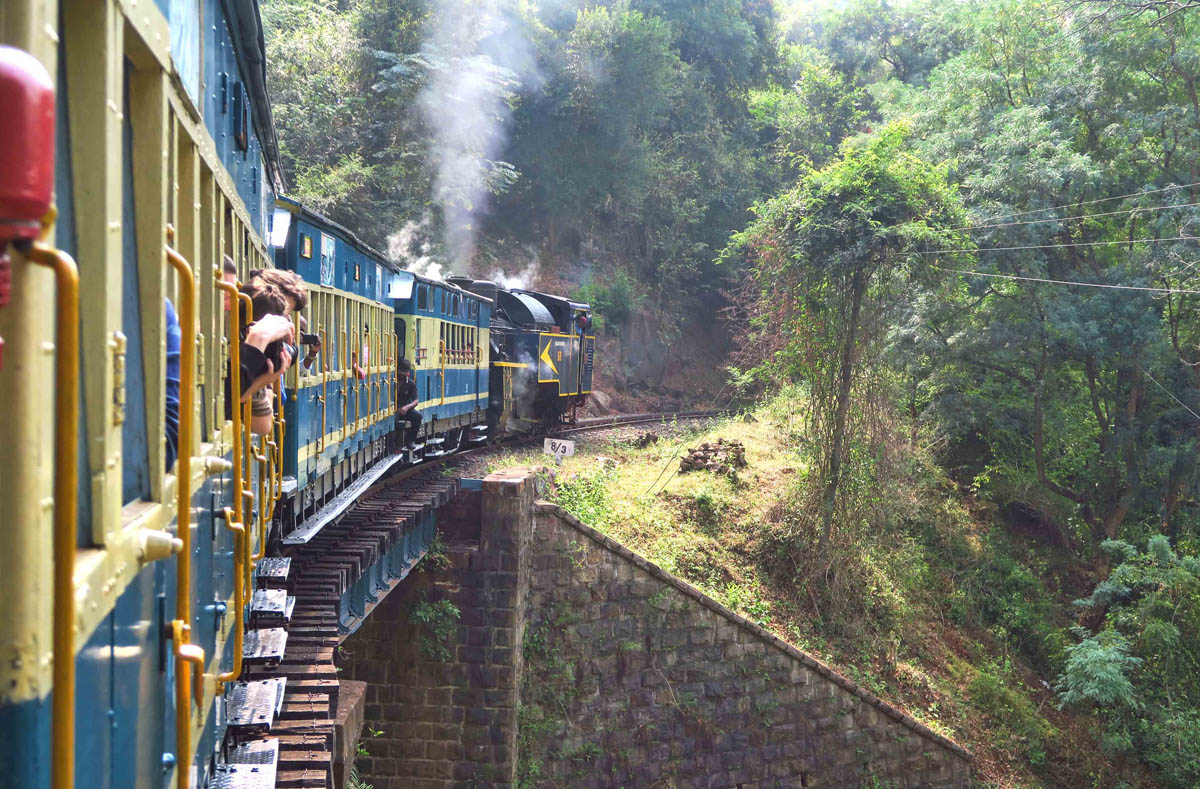
Looking back on the steam engine pushing us up the hill.

It doesn’t take long for the temperature to drop as we climb into the mountains.

The train makes stops along the way at scenic overlooks.

Check out my fellow passengers in my first class car. They look like a swarm of bumble bees!

I am typically the kind of person who avoids children at all costs, so you can imagine my horror when I first saw my fellow cabin mates! But these boys turned out to be the most polite, well behaved, amusing children I have ever had the pleasure of meeting.(Bunched together only for the purpose of a selfie, thank goodness!)
Friends and followers know how much I love a train ride. I’ve always been a bit of a train nut, going out of my way to ride the rails, particularly when the train has historical significance or notoriety. India’s entire rail system is noteworthy in its own right. With almost 60,000 miles of track traversing the length and breadth of the subcontinent, it’s the fourth largest railway network in the world employing 1.4 million people. Train travel in India is frequent, efficient, and affordable. Local passenger trains are not luxury travel by any means, but comfortable. In fact, the car interiors haven’t changed much since the month I spent traveling across India in 2002.
What has changed, however, is the integration of technology! Instead of waiting in line in the crowded train stations, it is now possible to buy tickets in advance online, choosing class of service and requesting seating type (upper, lower, side berth, etc) India’s train class is a bit confusing and requires a tutorial or two, but once you get the hang of what type of seat you prefer, it’s a snap to confirm. (Tip: Should you ever need train information regardless of country, be sure to check out “The Man in Seat 61.”) IRCTC even has an app for the smart phone that not only lets you see availability, but will tell you where your car is positioned along the route, on which platform the train will be arriving, and if the train is on time. Once I got the knack of it, I was able to wait at the exact spot along the platform for my assigned car. Just astonishing efficiency for such a chaotic culture!
India Railways also operates quite a few tourist trains with names like “Palace on Wheels” and “Maharajas’ Express,” all catering to well heeled travelers, both local and international. But by far, the most intriguing trains are famous not for their luxury, but for their historic significance and impressive engineering feats. Three of these mountain railways have been grouped together to be recognized as “Mountain Railways of India,” a UNESCO World Heritage Site: the Darjeeling Himalayan Railway, the Nilgiri Mountain Railway, and the Kalka Shimla Railway.
Spread far and wide across the subcontinent, this trio of mountain railways utilizes a series engineering marvels in the form of switchbacks, loops, hairpin turns, tunnels, and bridges to gain significant altitude at a sustainable grade. These historic railways serve as a “Holy Trinity” to a train nut like me. I had hoped to ride all three.
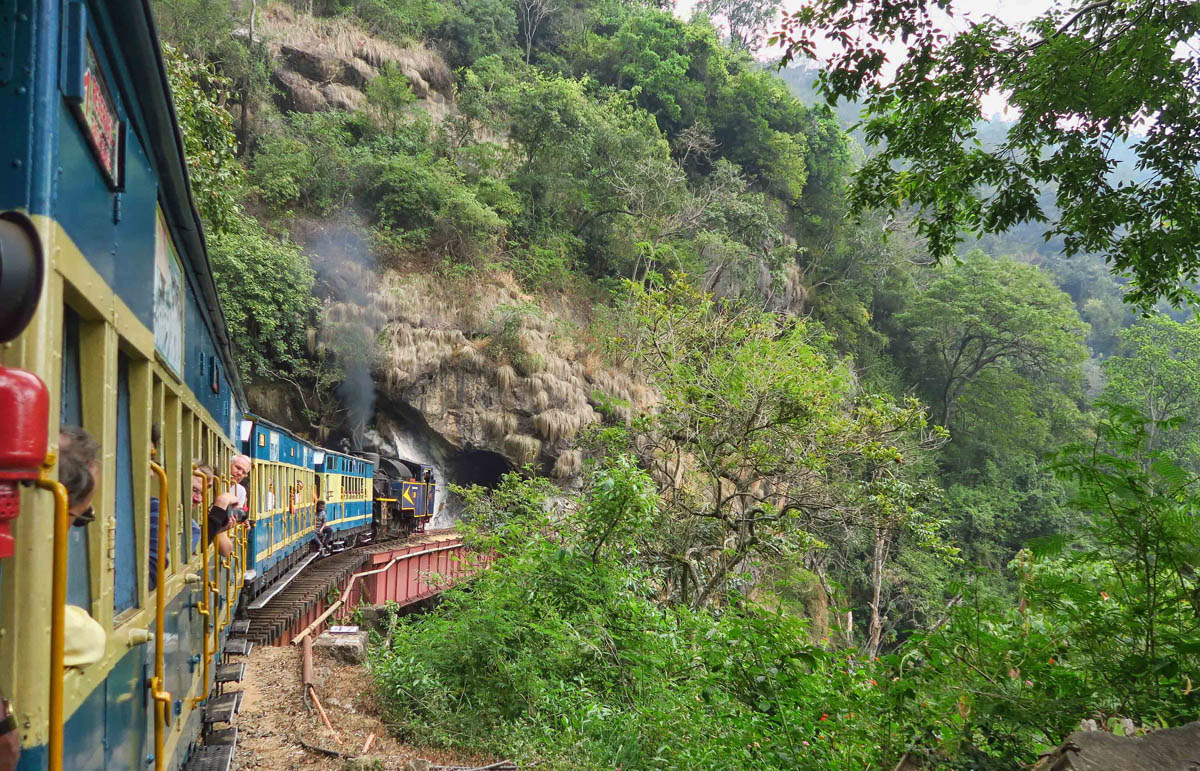
Climbing to over 7,000 ft in 30 miles gives this train the distinction of being the steepest rail system in Asia.

The scenery along the way is gorgeous, as we pass waterfalls and rivers as we travel through 208 curves, 16 tunnels, and 250 bridges along the way.

The train makes a stop at Hillgrove Station where we are given tokens for a masala chai (tea) and pastry. There are quite a few “locals” who await the arriving train.
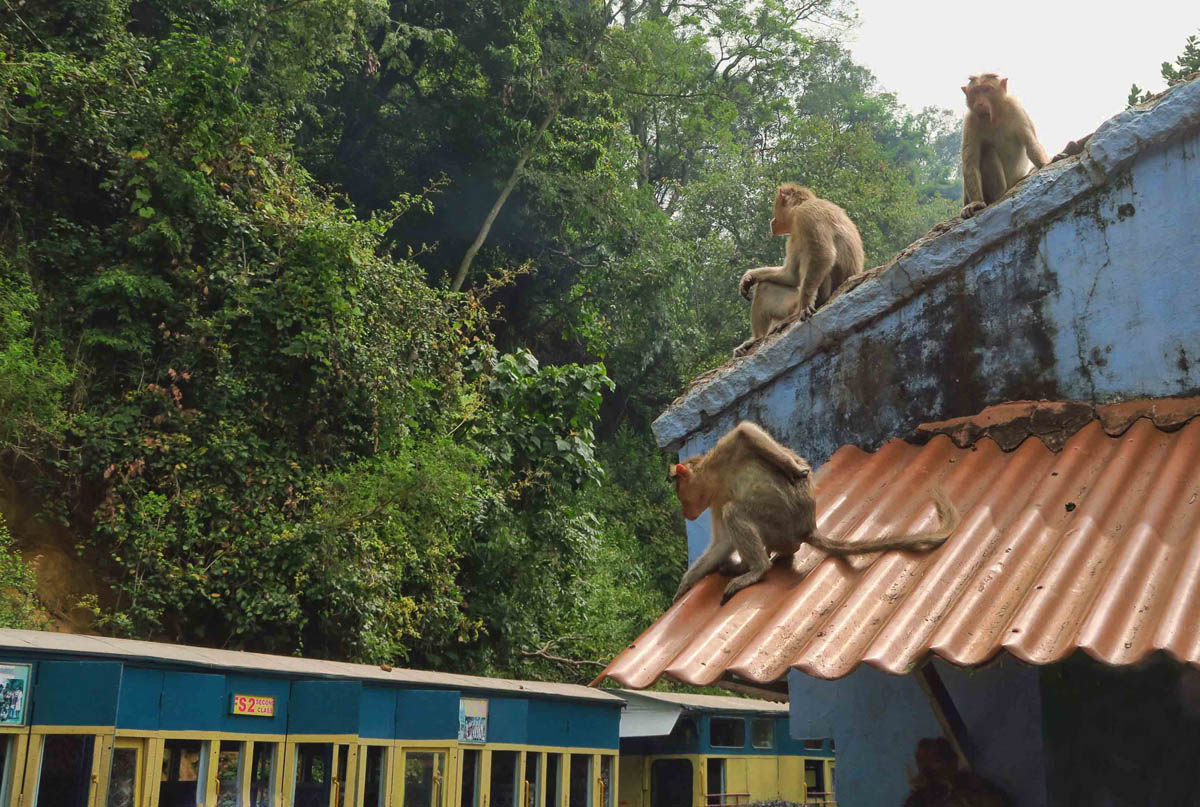
Lying in wait from the rooftop overhead, they have become quite skilled at snatching pastries out of the hands of unsuspecting passengers.

I wonder what’s become of the monkey population now that the train has temporarily stopped running.
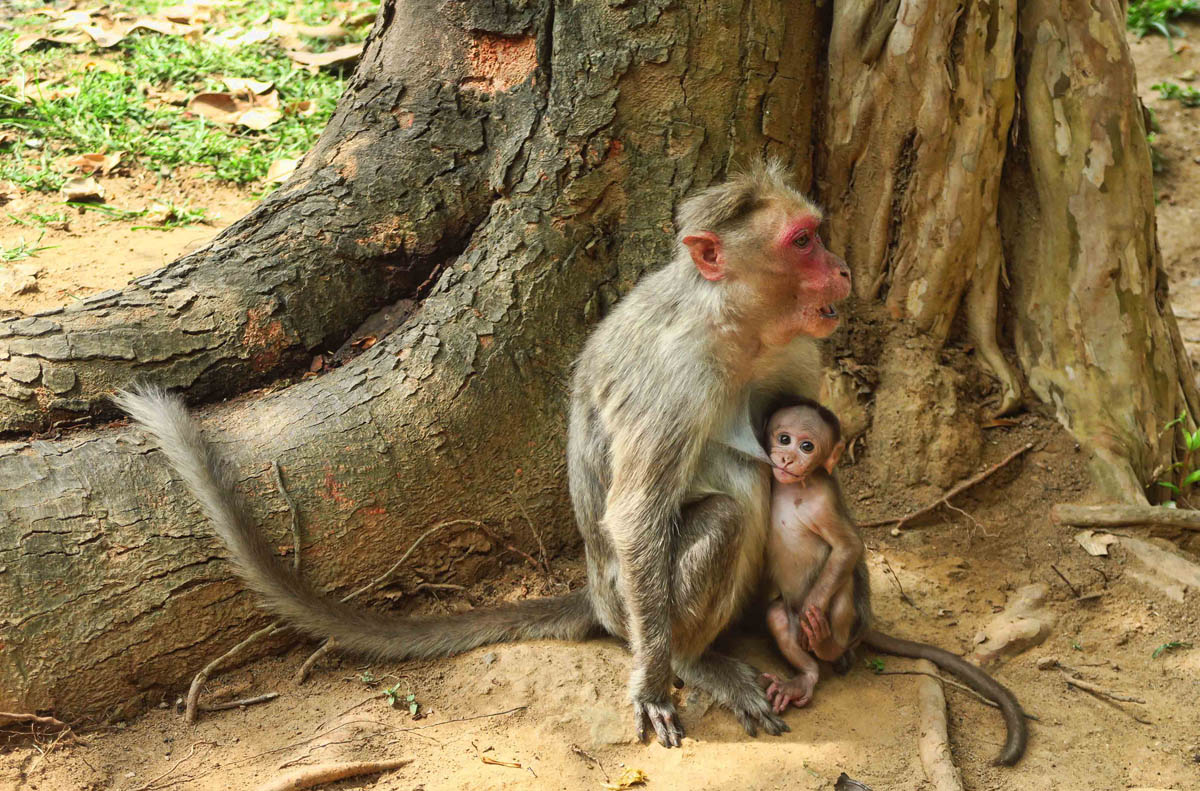
That’s gotta hurt!

Steam engine filling up. We’ll soon be leaving it behind in exchange for an oil fueled locomotive.
The British are credited with much of India’s railway system, as they orchestrated the building of railways in the late 19th and early 20th century, primarily for transporting goods across the country. The railways also provided access to India’s “Hill Stations,” small towns high in the mountains providing ideal climate for growing the Brit’s favorite beverage, tea. These hill station towns evolved into mountain resorts, providing an escape from India’s oppressive heat and humidity to the cool mountain air. Therefore, these mountain trains became known as the “Hill Station Trains.” Each one of these historic mountain trains has some feature which makes it unique.
My first experience in riding one of the hill station trains was back in 2002, when I rode the Darjeeling Himalayan Railway train, which covers 55 miles from Siliguri to Darjeeling. Opened in 1881, it was the first of these hill station trains, and still serves today as the “Darjeeling Mail Train.” Beginning at 330 ft elevation, rising to 7,200 ft, it does so via a series of loops and switchbacks. The steepest sections with the greatest elevation gain are achieved through use of the “Z-reverse” whereby an engineer steps off the train and switches the track, allowing the train to zigzag up the mountain by reversing directions. I wish I had better photos of this amazing train journey, as I recall men hanging off the train, riding on the roof, etc. However, this was back in the days before digital photography where I had only 36 snaps per precious roll of film.
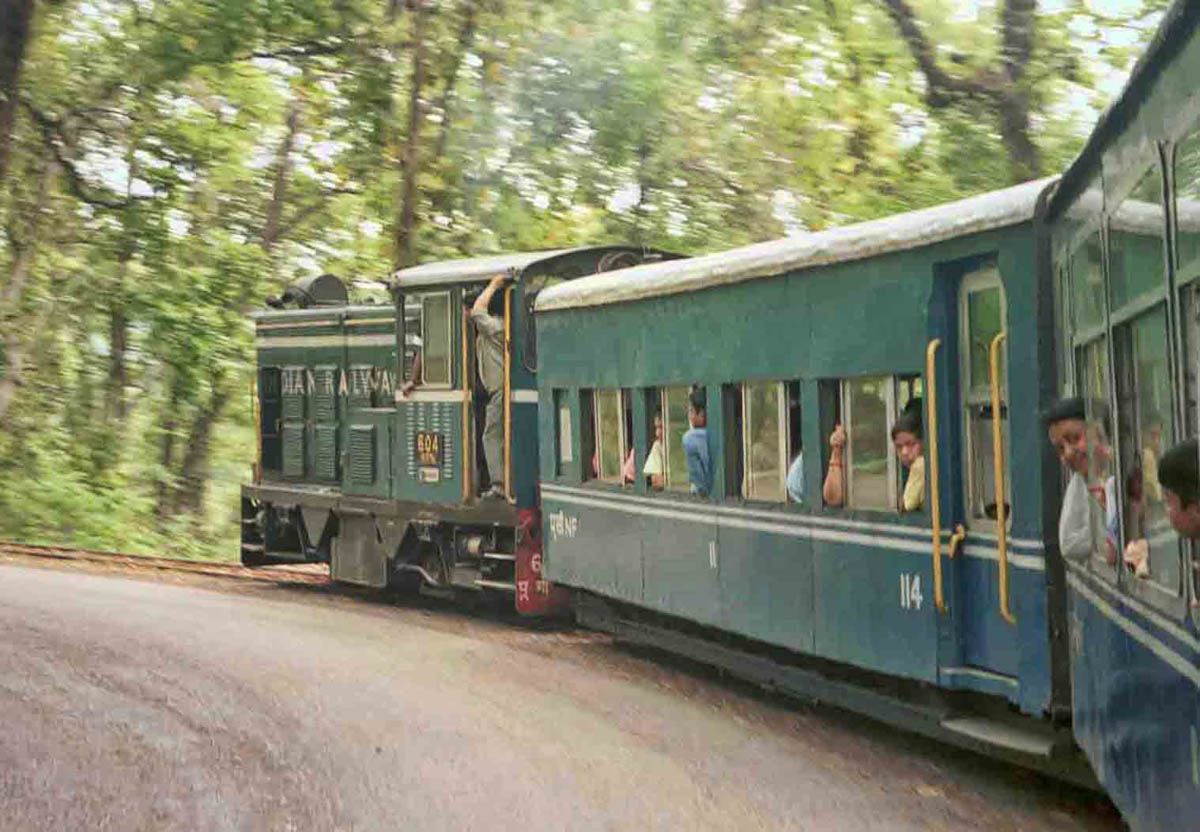
This photo is a digital scan from a negative taken in 2002 of my ride on the Darjeeling Himalayan Railway. Wish I had taken more photos on this ride, but back then, a “roll of 36” was a lot!
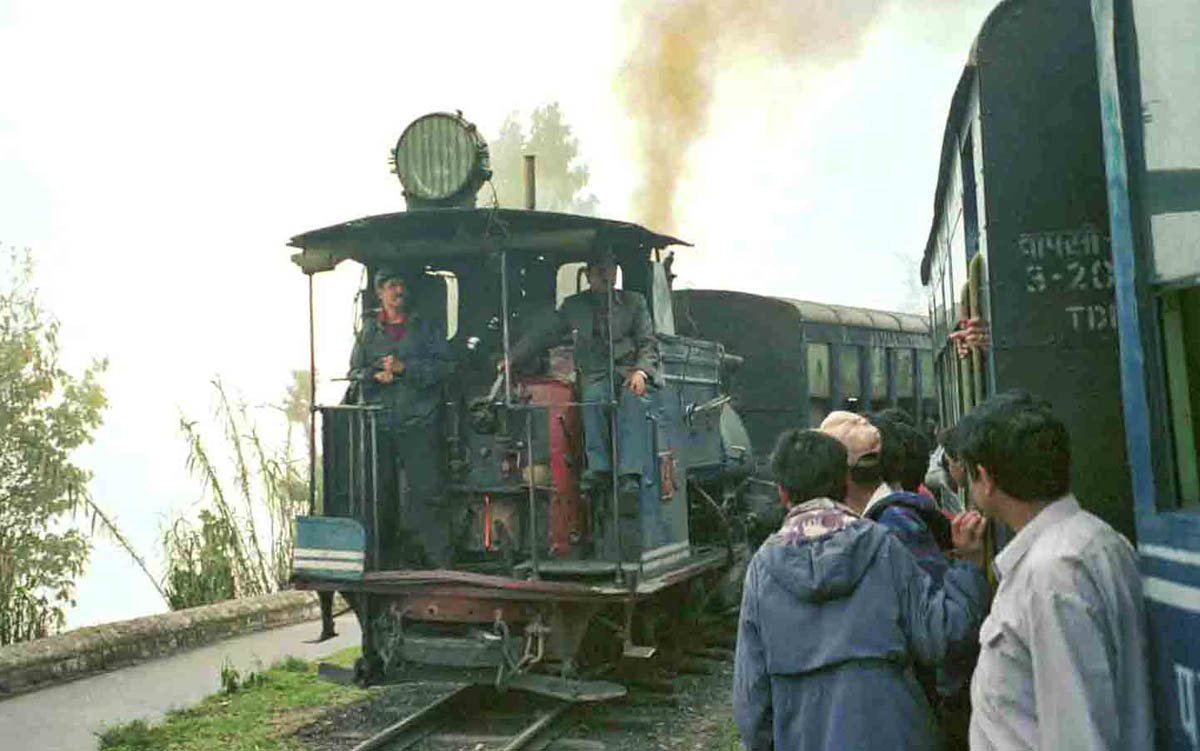
The Darjeeling Himalayan Railway, built in 1881, was the first of the three trains to be recognized by UNESCO World Heritage in 1999. It incorporates four loops (spirals) and four ‘Z’ reverses, or zigzags. (Photo is digital scan of film negative from my 2002 trip across northern India.)
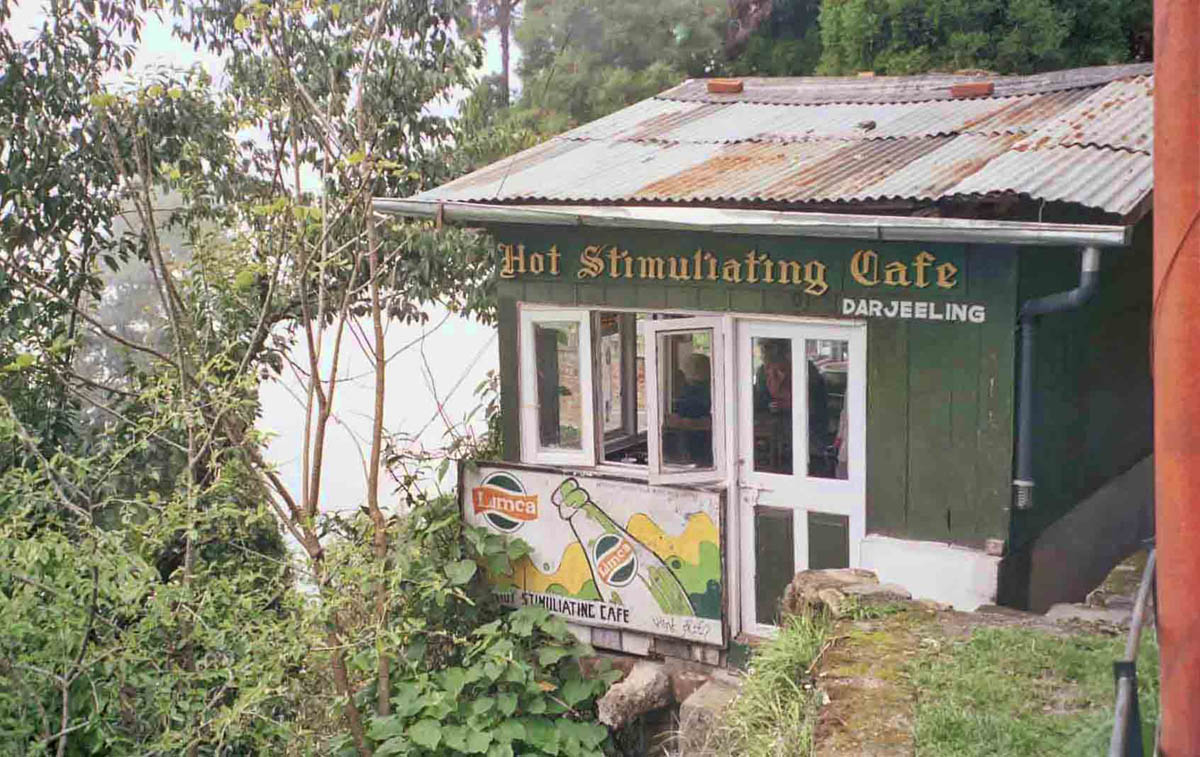
I loved all the unique stops along the route such as the “Hot Stimulating Cafe” hanging off the side of the mountain.
The Nilgiri Mountain Train would be my second in the Mountain Railways of India trifecta, traversing only 29 mi from the town of Mettupalayam to the hill station of Udagamandalam, (also known as Ootacamund, or “Ooty” for short. Is it any wonder?) The route is named after the Nilgiri Hills, also known as the Blue Mountains of Southern India.
Train tickets go quickly on these trains, as not only are they a major tourist attraction, they also still serve as the major method of transport feeding off the main line into the hill stations. Not being able to find availability online, I decided to try a travel agent in Fort Kochi upon my immediate arrival into India.
During my first attempt at obtaining a ticket, I was told it was “impossible.” The train had been booked up for months. I protested, “But you didn’t even ask when I wanted to travel! What if I have ‘months’ to wait? You didn’t ask how many seats I need. Only one. There’s always room for one more!” He wouldn’t hear it. Wouldn’t even bother to check. So I left and went to the travel agency around the corner, where the man (who turned out to share my same last name) patiently looked through every day, one at a time. Finally, he found one remaining seat on Leap Day, the only availability for two months out. “BOOK IT!” I exclaimed! And so, reluctantly as Leap Day approached, I left the beach behind as I headed inland for Mettupalayam to cross off the second in my trifecta of the “Mountain Trains of India” train rides.
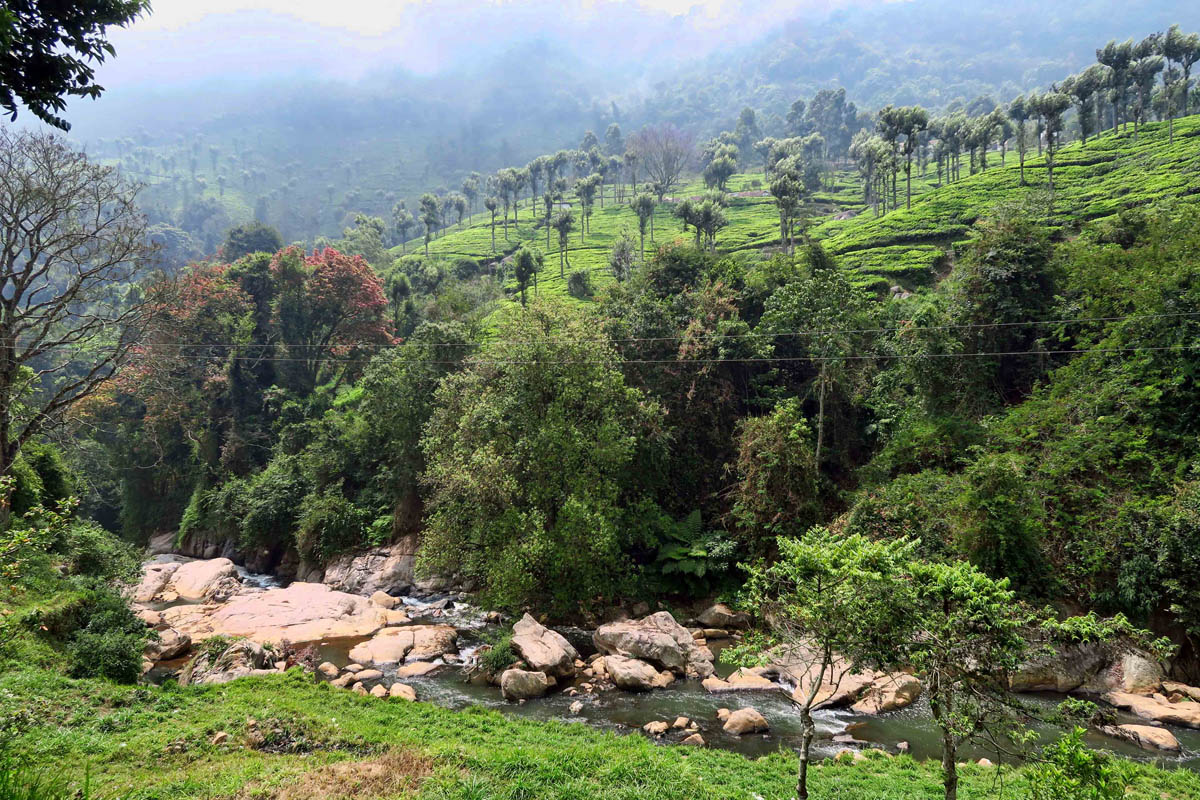
We climb higher and higher toward Coonoor, the second largest hill station in the Nilgiri Mountains. This beautiful hill station is famous for its tea estates.
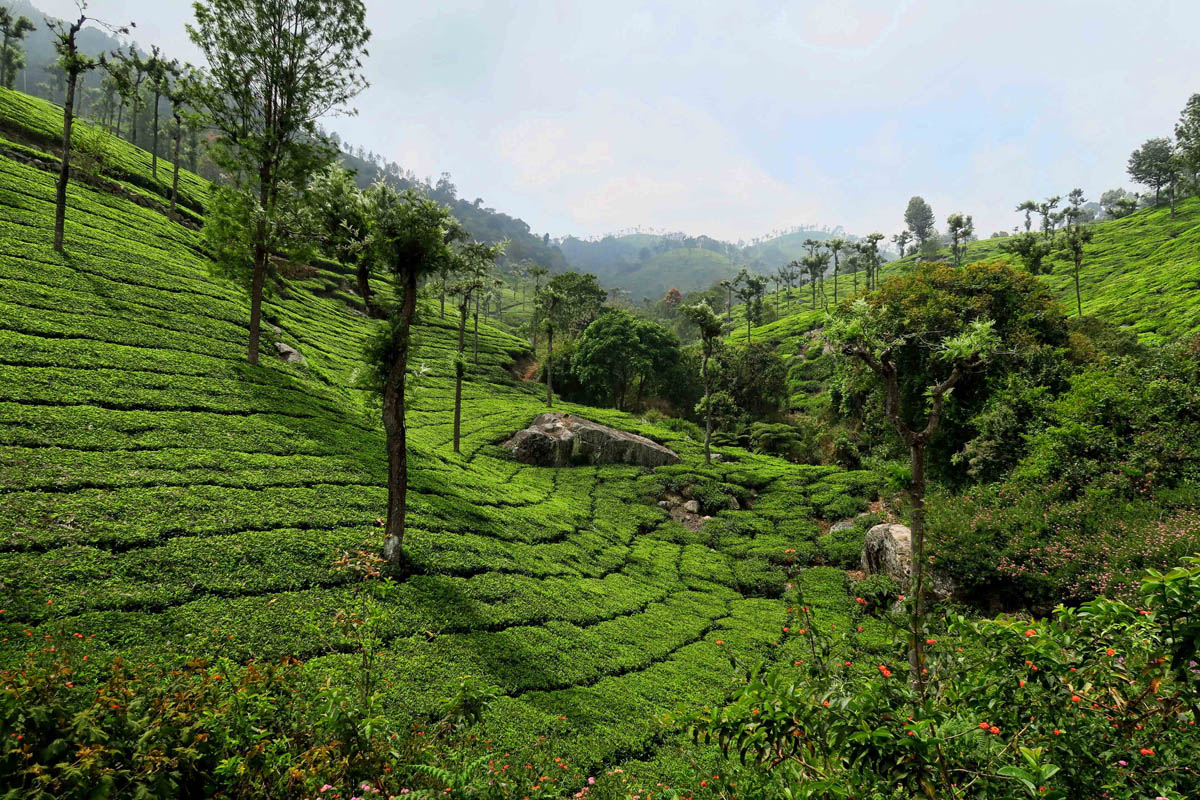
The train passes through many tea plantations. Easy to see why this area had such significance for the British, who love their tea!

As we climb higher, we go through some eucalyptus and pine forests
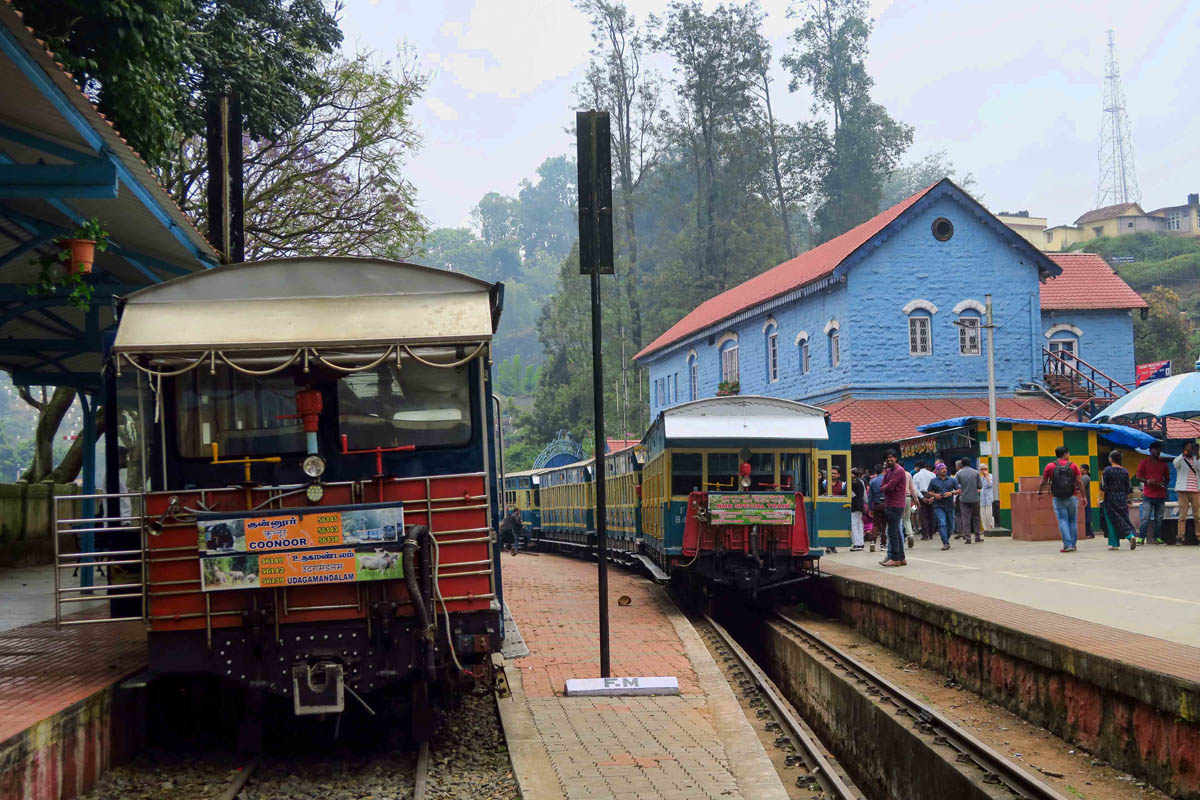
We stop at Coonoor to switch engines.

In addition to historical significance and scenic beauty, this is the feature that makes this route unique. It is the only “rack track” in India, using the rack and pinion system to pull the train up the mountain.
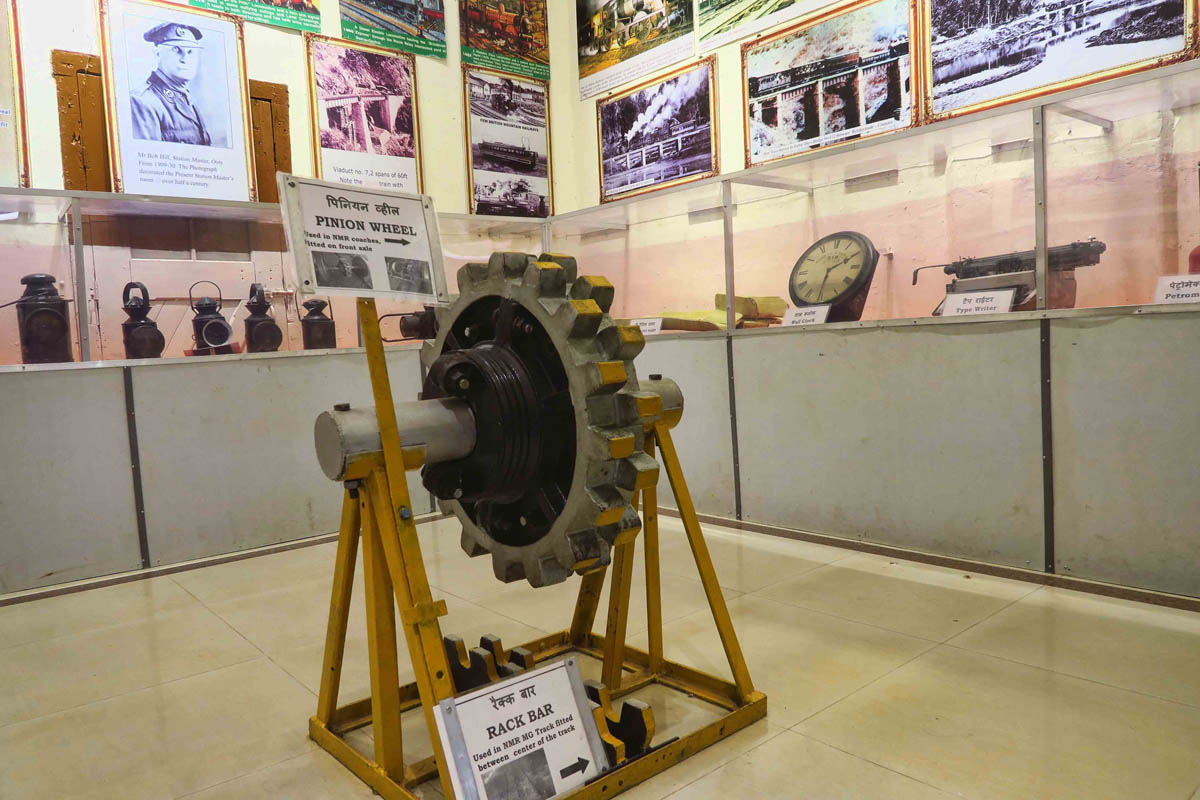
This rack and pinion mechanism is on display at the small railway museum in Ooty Station.
Unfortunately, the third of India’s Mountain Railways will have to wait. I had a ticket booked on the Kalka Shimla Railway in the foothills of the Himalayas of northern India in late March. My plan was to cross it off the list on my way to meet my tour of Pakistan. We all know how that ended.
I hadn’t planned to ask India Railways for a refund. Since my Kalka Shimla ticket was less than twenty bucks, I figured requesting a refund from the USA during a pandemic crisis was more trouble than it was worth. However, I didn’t have to request it. The refund came about a month after I returned, along with a polite note explaining that all train travel had been suspended. The height of efficiency amidst corona chaos!
On March 22, 2020, India’s lifeline of passenger trains ceased to operate for the first time in its 167 year history in attempt to combat COVID-19. While freight trains continued to run, the 13,500 trains that carry over 23 million passengers daily, the equivalent to moving the entire population of Australia, would cease to offer passenger service for the next 51 days. Think of that the next time you hear someone say the virus is just another flu, or “a hoax cooked up by the Democrats.”

While my hotel, Al Woodlands Residency, is a bit above the town of Ooty, I chose it because it is adjacent and has a view of the Government Rose Garden.
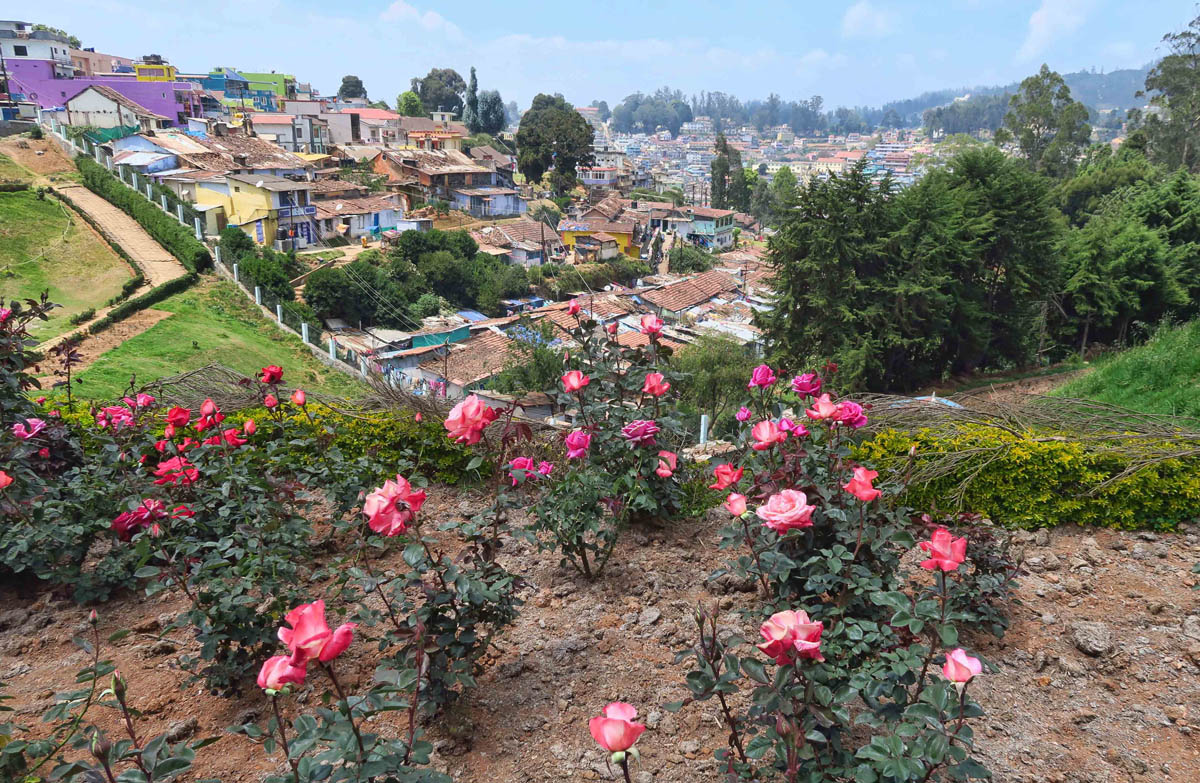
This hill station’s official name is Udhagamandalam. It was once called Ootycamund or “Ooty” for short, and the name stuck.

The Government Rose Garden in Ooty contains 27,000 rose plants. It’s considered “winter” now (photo taken March 1st) so not as much is in bloom.

Still, there are enough blooms to keep my nose occupied for a couple of hours while I enjoy the cool mountain air!

These women are preparing the beds for spring by hauling smelly manure in these baskets atop their heads.

While these look like dead bushes at first glance, they are actually new plants protected by surrounding them with dead brush.
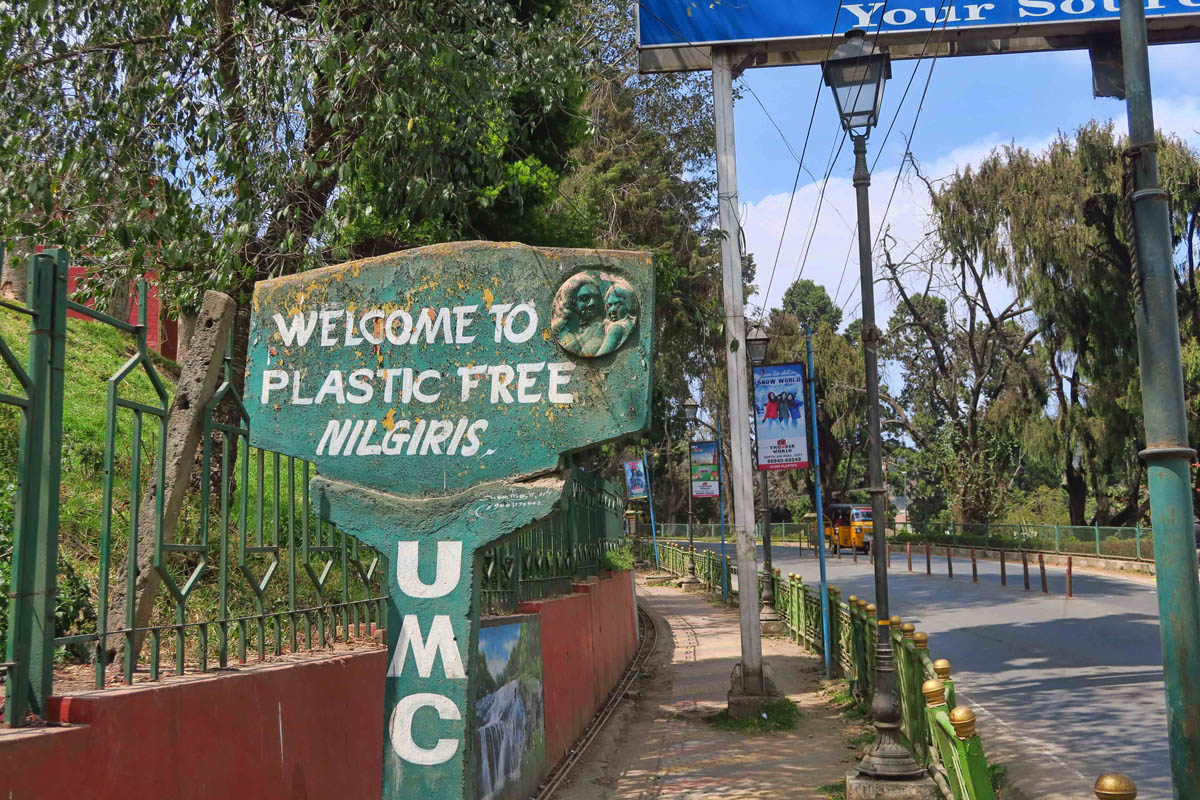
So many cities in India are becoming “Plastic Free” zones. You can only buy water in large jugs (to refill your smaller bottle) and sodas are only available in recyclable cans. Markets and shops must bag merchandise in paper. Hope it’s a movement that perpetuates.
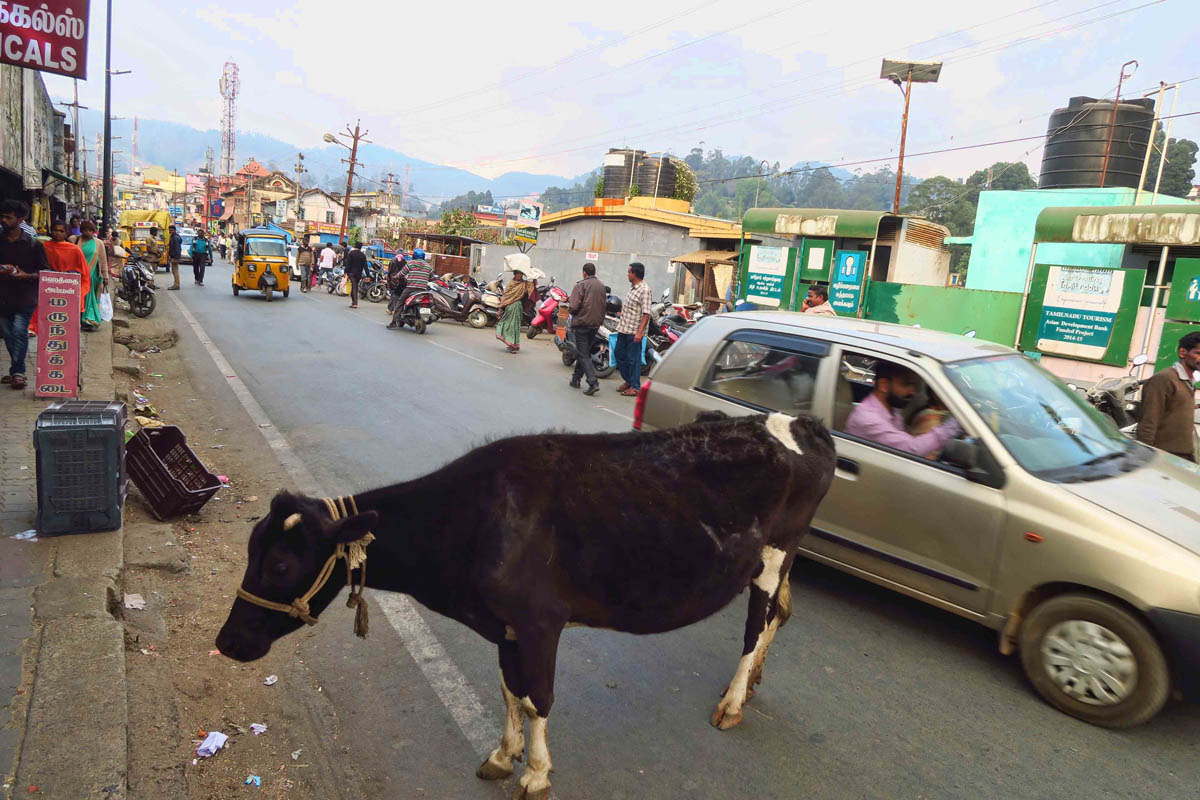
A typical scene in any town in India. Cows are considered sacred by the Hindus, therefore free to roam anywhere…even through the trash bin.
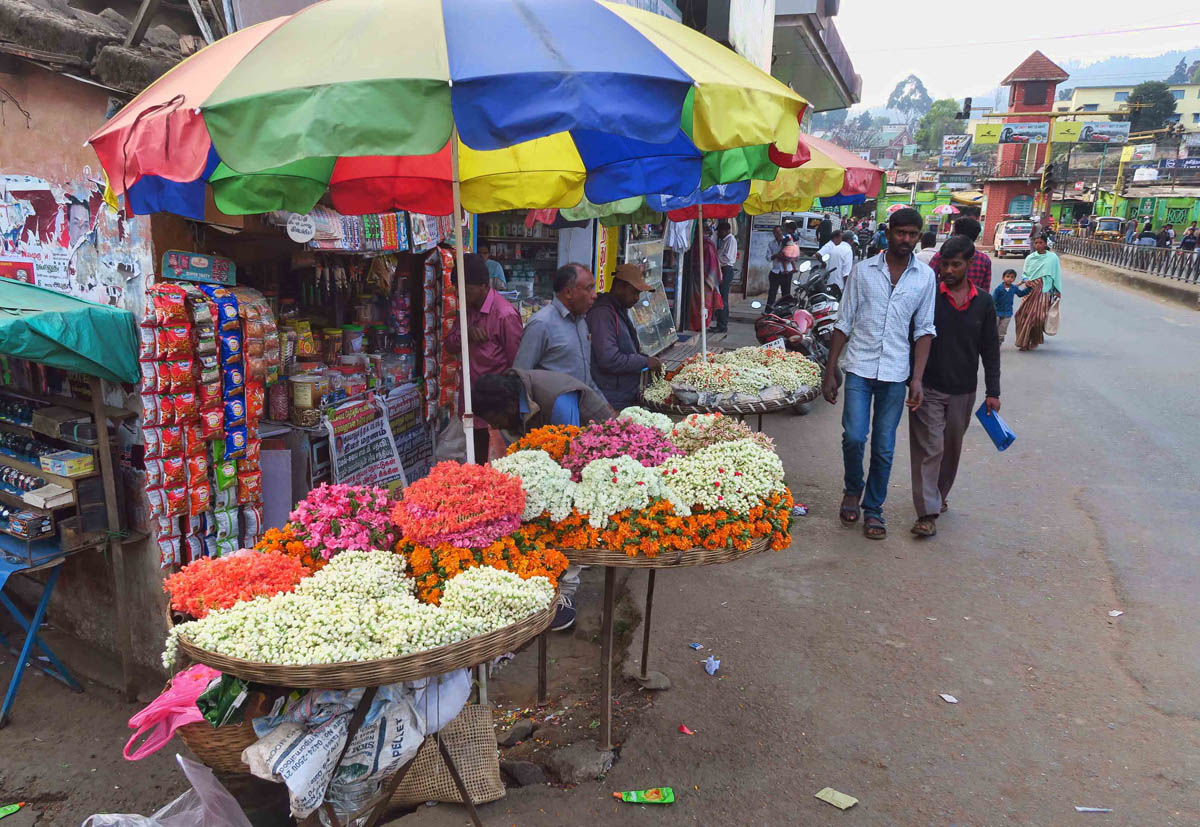
Flower stands are in abundance outside all Hindu temples.

Marigolds are considered pure and are traditionally offered to honor all gods and goddesses by displaying as an offering inside the temple.

The beautiful photos would be a tad boring without your stories, and your stories would be a tad boring without the photos! Your posts are always a delightful and unique symbiotic pairing of the two.
“Boring” was a poor word choice, I meant “meaningless”. Biden and I share a penchant for gaffes 🙂
Nothing lifts my spirits during a lockdown like being told the one thing I hold dear is “boring.” Unless of course, it’s being told it’s “meaningless.” LOL!!! Thanks, Terri. Maybe best leave it at that before I reach for the Xanax with a bourbon chaser. 😉 😉 😉
Thx for being a good sport Suzanne, I really did mean to explain (poorly I see now) how the pairing of your words and photos result in a great presentation that’s much better than each standing alone. Forgive me for being inarticulate 🙂
This sounds so much better now.
It’s hard enough being somewhat isolated and ‘staying at home’ during this pandemic time but seeing these photos (a tad boring??) and reading your stories makes this almost unbearable. Wouldn’t it be wonderful to be staring out a train window somewhere right now? Wondering where you’re holed up? I’m just hanging out in Tucson and hoping all the idiots out partying aren’t going to cause this to become more of a nightmare than it already is. Hoping to be in the van soon…
Hi, Kat. Still holed up on the farm in TX. Hope you get away in the van soon. Here in the Lone Star State, it’s like there never was any stinkin’ virus, save for a few of us last remaining masked holdouts.
Please do let me know your travel plans so I can live vicariously.
Hi Suzanne,
I’m really getting irritated with the unmasked and worried about new surges popping up (I’m not sure surges actually pop up but you know what I mean). When I go I’ll be headed to Colorado to visit Jeff (my son❤️) and family in Missouri. From there, who knows…maybe up to Oregon. I sure do miss the coast.
And I’m definitely the one who has been living vicariously through your posts.
Hope our paths cross again some day soon!
Another wonderfully told adventure. So much more to India than I’d ever imagined. And to think I thought my trip on the Chihuahua al Pacifico train thirty something years ago had a lot of tunnels, twists, and turns! There are lots of improvements technically with digital photography but you made each picture count when 36 was a roll.
Thanks, Jim. One of the greatest gifts my brother Don ever surprised me with was to scan all my old negative film from that RTW year-long trip into digital format. If I could have known then what I know now, I would have taken more!
Did you know that we have been to India twice, the first time mere months before the Gulf War. On our second trip we did the Palace on Wheels. Colin needless to say brought copious rolls of film, at least 100 rolls ( both trips ) and he used them all. Sadly they are all in slide format. Wonderful blog mi amiga.
Great escape! Very beautiful!
Beautiful pictures, with scenery like that and those trains I can see why you have a fascination with them!
What a great trip that was. At least you got one more train before having to head home.
The photos, the stories, the words……. I anxiously look forward to them and appreciate the adventure even more so during this quarantine period. Hope you have more saved up.
“Railway termini are our gates to the glorious and the unknown.” ~ E.M. Forster
This is a lovely post, Suzanne. I was reminded of the many train rides I enjoyed in the early 60’s in Germany, exploring the country with my parents…and then again in the mid 70’s as a young adult riding trains for discovery in Italy, from Milano to Vicenza, Verona to Pisa. The excitement of fast moving scenery, the anticipation of disembarking onto foreign platforms…all wonderful remnants of my past, woven into a colorful tapestry which continues to be wrapped around my heart. It is delightful to reminisce through your words and photographs. Thank you.
A great spectacle and with the cog railway, right up there with the Glacier Express. ‘Cept different.
Cheers!
I enjoyed this post so much. My family originated in Ooty! Never been myself, and sadly the family stories have died with the tellers.